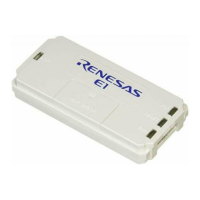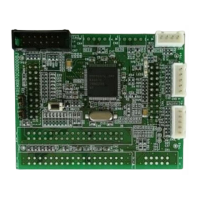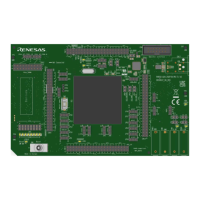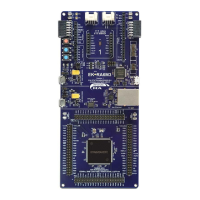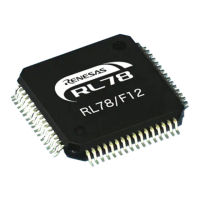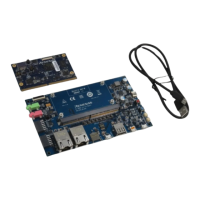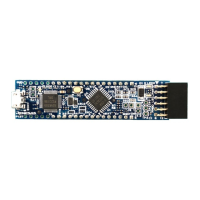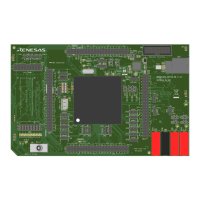5
5-11
INTERRUPT CONTROLLER (ICU)
32180 Group User’s Manual (Rev.1.0)
5.3 Interrupt Request Sources in Internal Peripheral I/O
The Interrupt Controller receives as inputs the interrupt requests from MJT (multijunction timer), DMAC, serial I/O,
A-D converter, RTD and CAN. For details about these interrupts, see each section in which the relevant internal
peripheral I/O is described.
Table 5.3.1 Interrupt Request Sources in Internal Peripheral I/O
Interrupt Request Sources Contents Number of ICU Type of Input
Input Sources Source ( Note 1)
TIN3–6 input interrupt request TIN3–TIN6 inputs 4 Level-recognized
TIN20–29 input interrupt request TIN20–TIN29 inputs 10 Level-recognized
TIN12–19 input interrupt request TIN12–TIN19 inputs 8 Level-recognized
TIN0–2 input interrupt request TIN0–TIN2 inputs 3 Level-recognized
TIN7–11 input interrupt request TIN7–TIN11 inputs 5 Level-recognized
TMS0,1 output interrupt request TMS0, TMS1 output 2 Level-recognized
TOP8,9 output interrupt request TOP8, TOP9 output 2 Level-recognized
TOP10 output interrupt request TOP10 output 1 Edge-recognized
TIO4–7 output interrupt request TIO4–TIO7 outputs 4 Level-recognized
TIO8,9 output interrupt request TIO8, TIO9 outputs 2 Level-recognized
TOP0–5 output interrupt request TOP0–TOP5 outputs 6 Level-recognized
TOP6,7 output interrupt request TOP6–TOP7 outputs 2 Level-recognized
TIO0–3 output interrupt request TIO0–TIO3 outputs 4 Level-recognized
DMA0-4 interrupt request DMA0–4 transfer completed 5 Level-recognized
SIO1 receive interrupt request SIO1 reception-completed or receive error interrupt 1 Edge-recognized
SIO1 transmit interrupt request SIO1 transmission-completed or transmit buffer empty 1 Edge-recognized
interrupt
SIO0 receive interrupt request SIO0 reception-completed or receive error interrupt 1 Edge-recognized
SIO0 transmit interrupt request SIO0 transmission-completed or transmit buffer empty 1 Edge-recognized
interrupt
A-D0 conversion interrupt request A-D0 converter’s scan mode one-shot operation, 1 Edge-recognized
single mode or comparate mode completed
TID0 output interrupt request TID0 output 1 Edge-recognized
TOU0 output interrupt request TOU0_0–TOU0_7 outputs 8 Level-recognized
DMA5–9 interrupt request DMA5–9 transfer completed 5 Level-recognized
SIO2,3 transmit/receive interrupt SIO2,3 reception-completed or receive error interrupt, 4 Level-recognized
request transmission-completed or transmit buffer empty interrupt
RTD interrupt request RTD interrupt generation command 1 Edge-recognized
TID1 output interrupt request TID1 output 1 Edge-recognized
TOU1,2 output interrupt request TOU1_0–TOU1_7 outputs, TOU2_0–TOU2_7 outputs 16 Level-recognized
SIO4,5 transmit/receive interrupt SIO4,5 reception-completed or receive error interrupt, 4 Level-recognized
request transmission-completed or transmit buffer empty interrupt
A-D1 conversion interrupt request A-D1 converter’s scan mode one-shot operation, 1 Edge-recognized
single mode or comparate mode completed
TID2 output interrupt request TID2 output 1 Edge-recognized
TIN30–33 input interrupt request TIN30–TIN33 inputs 4 Level-recognized
CAN0 transmit/receive & error CAN0 transmission or reception completed, CAN0 error 35 Level-recognized
interrupt request passive, CAN0 error bus-off, CAN0 bus error, single shot
CAN1 transmit/receive & error CAN1 transmission or reception completed, CAN1 error 35 Level-recognized
interrupt request passive, CAN1 error bus-off, CAN1 bus error, single shot
Note 1: ICU type of input source
• Edge-recognized: Interrupt requests are generated on a falling edge of the interrupt signal supplied to the ICU.
• Level-recognized: Interrupt requests are generated when the interrupt signal supplied to the ICU is held low. For
this type of interrupt, the ICU’s Interrupt Control Register IRQ bit cannot be set or cleared in software.
5.3 Interrupt Request Sources in Internal Peripheral I/O
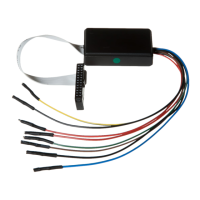
